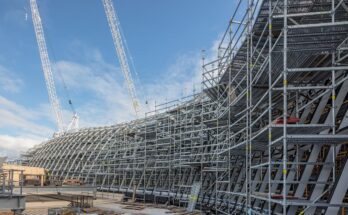Construction projects are more environmentally conscious than ever before in today’s society. To do so, there are several steps in the process such as selecting environmentally friendly materials, recycling scrap materials, being environmentally conscious of where to build, and installing energy efficient devices.
The material selection process is very important because certain material have a bigger impact than others on the environment. Contractors and builders are now looking for material and ways to reduce the environmental impact by using recycled wood, steel, and latex materials in the construction process. These are certain things that the contractor can do to earn points to be LEED certified, which means that it will be accredited and certified as an environmentally friendly building.
Besides the material, where the material is from is also a great consideration in green building as well. For example, using local concrete contractors locally for structural support for a Bay Area construction project is considered to be more environmentally friendly than shipping steel from overseas from countries from Asia. Although steel is a more environmentally friendly, the energy used to ship steel from overseas is more harmful to the environment than buying concrete locally. Doing these projects, there many materials that can be recycled such as the chopped wood and leftover steel. Recycling unusable material is also part of the LEED accreditation process, which recognizes the steps the building took to becoming more environmental. Using recycled material for concrete mixes instead of fresh material will reduce the impact on the environment.
Also See : How to Go Green?
The design process itself can reduce the impact on the environment because if the structural engineer can design a building to withstand the same tributary forces applied by using fewer materials involved to begin with, it will greatly reduce the construction cost and the overall environmental impact while optimizing the life-cycle of the building.
Being careful of the wildlife and the endangered species is also an important consideration as well. Environmental impact studies show the long-term damage on the marshes and swamps that the building process will do. Ways to reduce or to avoid it will be considered, so there will not be poisonous materials to the fish or birds in their habitat. Environmental impact studies and reports will affect the design process and ultimately the construction process and the end product of how the building will be constructed as well.
Also Check : 3 Ways to Go Green at Home
Green construction is not only beneficial for the environment, but for society as well. By picking non-toxic materials to construct, it not only improves indoor air quality; it improves the well-being of the occupants of the building. Properly designed buildings can minimize the need to repair and maintain the building. For example, by installing efficient energy devices lighting and water devices from the beginning, it saves money and the overall impact on the environment. Also, better insulation for the building can prevent the need to turn on the heater during the winter. Plastic insulation has been used as a sustainable way to keep the heat inside the buildings, maximizing its energy efficiency. Plastic insulation saves more than 200 times the energy over its lifetime, and it is very high in thermal efficiency, which also adds to savings.



